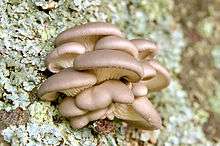Pleurotoid fungi
Gilled fungi with laterally-attached fruiting bodies are said to be pleurotoid (Gr.: pleurē + ōtos + -oid, literally "side-ear form" or "having the likeness of Pleurotus ssp."). Pleurotoid fungi are typically wood-decay fungi and are found on dead and dying trees and coarse woody debris. The pleurotoid form is polyphyletic, having evolved a number of times within the Basidiomycota.[1] Many species of pleurotoid fungi are commonly referred to as "oyster" mushrooms.[2] Laterally-attached fungi with pores rather than gills are referred to as bracket fungi.
Genera

Tectella operculata
Agaricales
- Cheimonophyllum
- Crepidotus
- Hohenbuehelia
- Hypsizygus
- Ossicaulis
- Panellus
- Phyllotopsis
- Pleurocybella — Angel wings
- Pleurotus — Oyster mushrooms
- Resupinatus — Oysterlings
- Schizophyllum
- Tectella
Russulales
- Lactifluus - some species
- Lentinellus
- Russula - some species
gollark: How wonderful.
gollark: Would the *goblins* have communicated with the city somehow?
gollark: ++data inc xp
gollark: This is clearly due to outdated racist attitudes.
gollark: BEE.
References
- Thorn, R.G.; et al. (2000). "Phylogenetic analyses and the distribution of nematophagy support monophyletic Pleurotaceae within the polyphyletic pleurotoid-lentinoid fungi". Mycologia. Mycologia, Vol. 92, No. 2. 92 (2): 241–252. doi:10.2307/3761557. JSTOR 3761557.
- Kuo, M. (February 2005). "Oysters: Pleurotoid mushrooms". MushroomExpert.com. Retrieved 2011-04-08.
External links
- Brown, Dorothy E.; Gibson, Ian (2003). "Trial field key to the PLEUROTOID SPECIES in the Pacific Northwest". Pacific Northwest Key Council. Retrieved 2011-04-08.
- Lincoff, Gary (2006). "Field Key: 6 Pleurotoid: oyster mushroom group". Northeast Mycological Federation Inc. Archived from the original on 2011-09-29. Retrieved 2011-04-08.
- Bojantchev, Dimitar. "Pleurotoid Fungi". MushroomHobby.com. Retrieved 2011-04-08.
This article is issued from Wikipedia. The text is licensed under Creative Commons - Attribution - Sharealike. Additional terms may apply for the media files.
